Dungeons & Democracy: Crowdwork As A Design Problem
Heckler war stories do very well. Imagine an organised insurrection. Sean has had one of his worst ideas ever, and can't wait to play it with you and 50 of our closest friends. (This is emphatically not a criticism of democracy as a concept.)
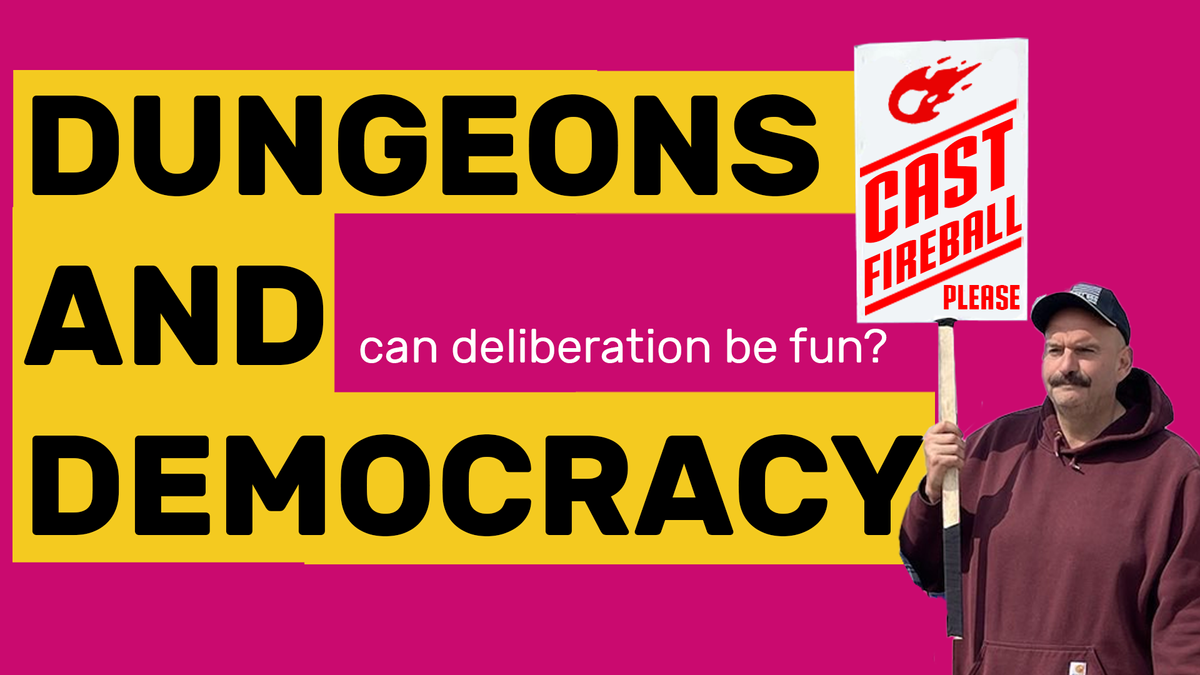
In this post I intend to tell you about an idea I’m working on. Not my best idea nor the real object of my work at the moment but my most tangled & frivolous idea, an intriguing side project and potential design nightmare in whose chewy corridors interesting questions arise.
The project is called Dungeons & Democracy. The objective is to make something that is both comedy show and interactive game that centres democratic collective decision making as its primary form of entertainment. Maybe you have questions already. Maybe you are disposed to imbibe all new information with a flat incuriosity. In either case, next I want to explain what is motivating this grand and ungainly ambition.
Why Make This?
(Why even want this?)
What if I told you deliberation was the new crowdwork?
There are many reasons to be squeamish about crowdwork in comedy. Increasingly, inclusive friendly comedy spaces treat it with suspicion. It’s too associated with the glib & bullish social mores of comedy’s seedy overbelly. These are contingent factors. It’s not crowdwork’s fault the air (environmental & ambient ideology of the UK) is filthy.
Crowdwork is fundamentally exciting. Too exciting, even. It’s tense with bad memories. Despite this, there are plenty of artists who make wonderful art and theatre and comedy through open honest discussions with the audience. They can open up the flow of a show to unexpected moments; talking to a stranger can exude a warmth and involve-edness. It makes the show feel 3D.
However, I’ve noticed a conservative throughline in all interactive crowd-involving comedy I’ve seen: all interactions go via the performer. The comedian speaks to the individual and the individual responds to them. The comedian gets a volunteer the volunteer is guided by the comedian. It is scary to interact with a stranger during your performance, they could say anything, but really the performer cedes nothing. They still control the space, the flow of conversation, they are solely equipped to narrativise proceedings. There is no real risk.
But what if you make a show where people are supposed to speak to each other instead?
Isn’t there something subversive and interesting about a show where the audience have to find the fun between themselves?
Couldn’t you risk them overturning the power structure of the show? What if they enjoyed each other’s company more than your performance and sense of humour? What if they began to resent having to stop talking and listen to the performer again when it was time for the ‘performancey bits’ to start again?
It all sounds incredibly exciting to me. Heckler war stories do very well. Imagine an organised insurrection.
A radical discursive comedy show escapes the economic logic of the touring show. Hammered to perfection, placed under glass and then trundled out to the provinces. A show like this could stay in one place, each show new, bespoke and communally owned. Regular faces coming slowly into focus as personalities, bit players and agitators. This could build [redacted].
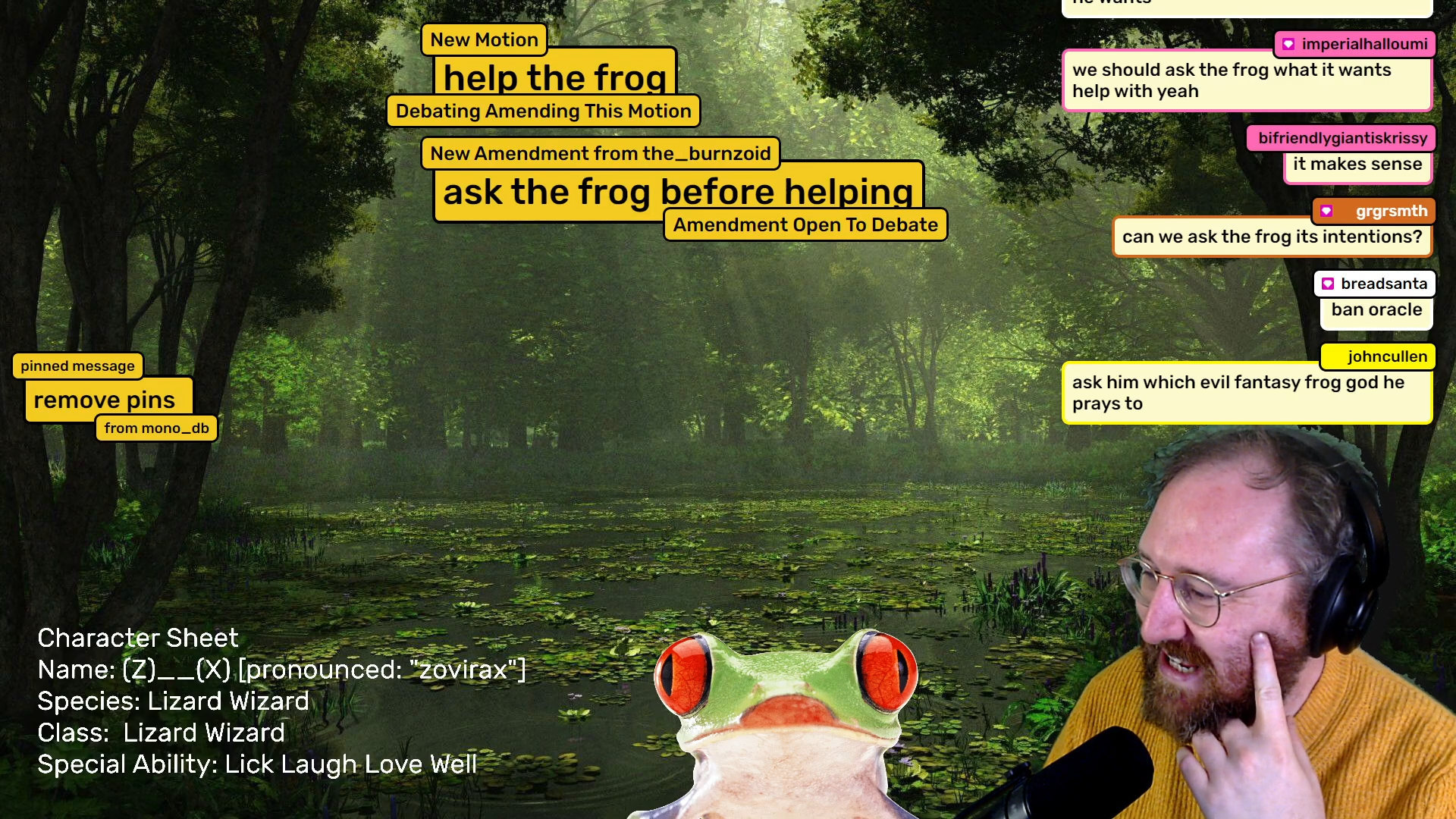
But I’m getting ahead of myself.
A crowd insurrection simulator is, for now, a romantic pipe dream.
Okay but what actually is it?
Instead, Dungeons & Democracy ploughs a more proceduralist furrow. Instead I am thinking practically about how to make an audience deliberation factory. What are the ideal conditions to get people to talk to one another?
Practically speaking I intend to trial this as a recurring livestream on Twitch then, when and if it coagulates into something real-feeling, it’ll graduate to a live show.
I want to borrow widespread traditional group decision making schema (think Robert’s Rules of Order, the procedures of Labour’s National Executive Committee, or large tradition unions like Unite etc.) and use those to organise the audience into controlling a single character through an extremely simple and silly Dungeons & Dragons flavoured scenario.
Half of the show will be the audience proposing, sponsoring, debating and voting on motions (which in this context will be interchangeable with actions). The other half is the performer(s) illustrating the results of those actions, explaining the consequences, voicing the characters and continuing the story.
I’ve made webpage that handles all the democratic and display. It monitors my twitch chat and can listen out for commands like !motion, !amend, !movetovote, !reject, !aye, !nay, !for, !against, !pointofinformation, !pointoforder, etc.
In a live show, I'd make a website people could access via their smartphone that would handle voting, display the current motion, etc. And then an altered widescreen display projected onto the stage.
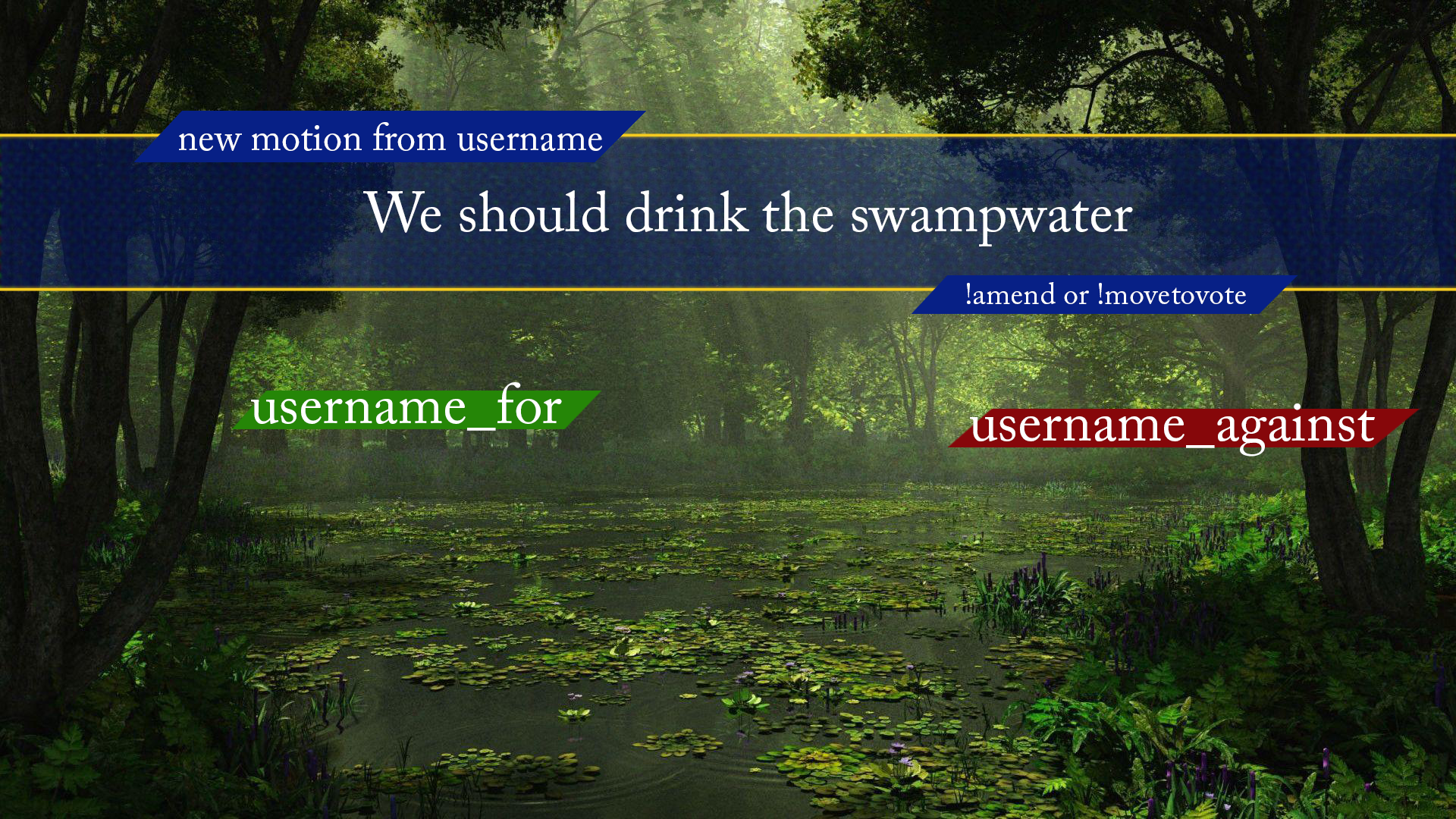
I want the show to have a connection with real & actually existing democracy. Unless you’re active in a trade union, co-operative organisation or you’re the secretary for your local anarchist cell, most people haven’t actually Done A Democracy(tm) beyond going to a converted church hall every two years, scratching an X onto a postcard and then placing it gently into a fire. The tagline of “we’re playing Dungeons & Dragons like a trade union” provides explanatory simplicity and familiarity to a concept where that is sorely needed.
Dungeons & Dragons too I chose because it’s the nearest familiar thing. Attendees need a think to deliberate about, they need something continuous that requires regular decisions. Dungeons & Dragons is something everyone has heard of (even if only a small number have played) that has deliberation and decision-making built in. Also hopefully it helps it find an audience amongst people who know how to have productive civil discussions about fictional decisions.
I feel positive about using this framework for an exercise in collaborative storytelling. My hope is that the low stakes of proceeding through a fictional narrative will keep the stakes low (thus encouraging participation) but also encourage greater investment as the story develops and people feel ownership over it (thus encouraging participation).
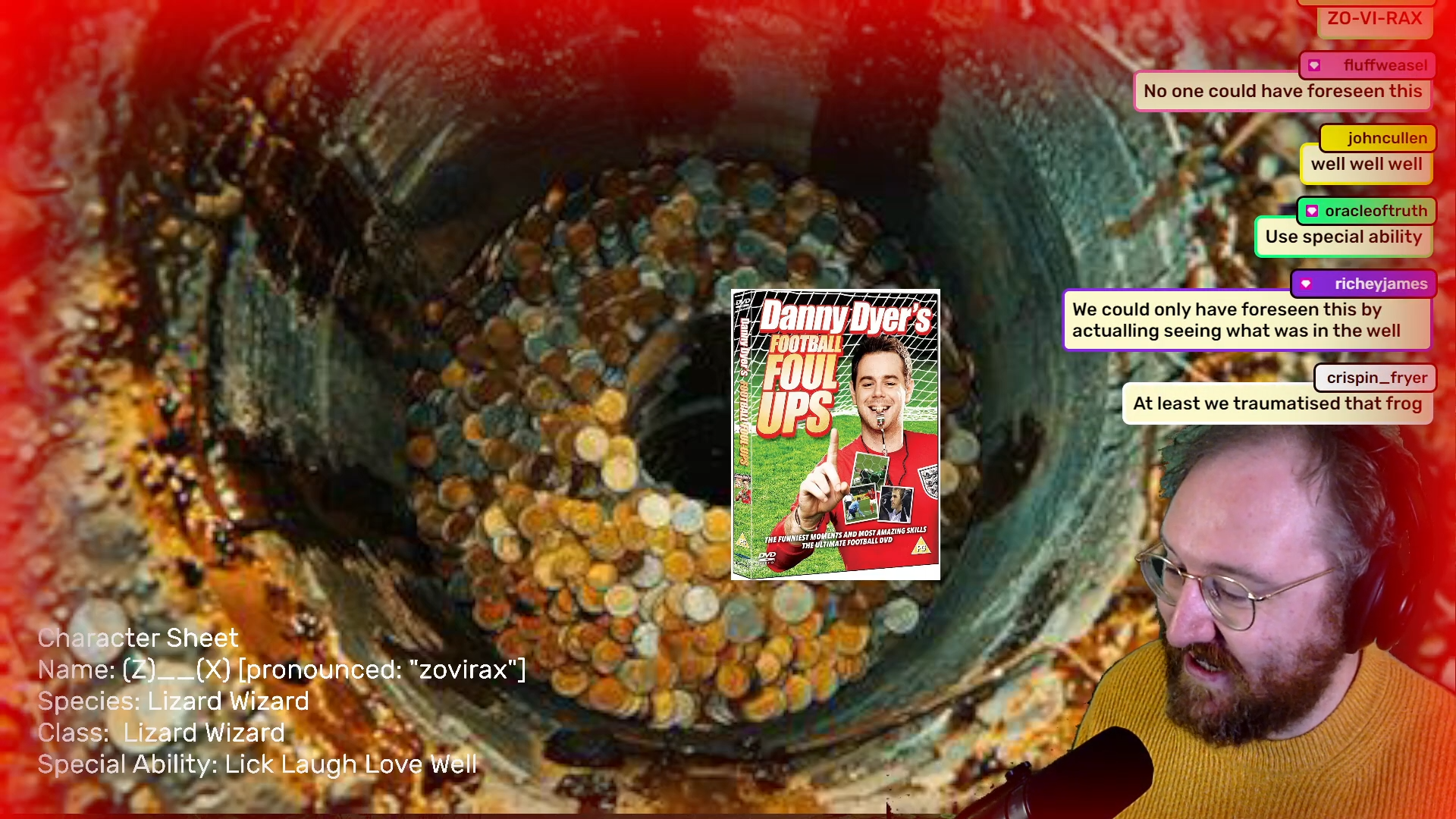
So that's the concept, the only problem is that there's loads of problems.
The Problem Vortex
aka The Marvellous List Of Agonies
1) The Dungeons & Dragons Themeing Narrows The Audience
I’m not overjoyed having to marrying this concept to a high fantasy setting. It's so removed from any subtextual commentary on real existing democracy - and it’s likely to narrow the audience significantly to people who think this is just for DnD people. Many of whom won’t be impressed by my relative inexperience and disinterest in DnD. I know what a goblin is and once it gets any more specific I'm going to sweat. I’d much sooner tell a story set in modern day Northern England, much like lockdown project Escape The North – but there’s no real cultural touchstone for a, for example, collaborative walking through Newcastle City Centre Simulator – suddenly the whole thing sounds more unclear and unfocused. At least with the DnD connection it creates a link to an audience who will definitely know how to engage with it.
2) Democracy Is Very Slow & Boring
The real procedures of real democracy are so slow and so dry. Yes it will be funny having to go through all these long-winded bureaucratic procedures just to, for example, hit an elf with a big hammer, but they can't last the distance. Inevitably the show will need to run on its own bespoke momentum-preserving democratic system which moves it further away from the real world it is trying to reflect.
3) The Problems Of Democracy Become Problems Of The Show
After one prototype test-stream I received a lot of useful feedback on the textural experience of fighting my horrible systems. A lot about the accessibility and clarity of information, ways to improve the flow of decision-making without departing too far from procedures I'm aping. Some of it, though, were just the problems of democracy. The show will and the story we are creating together will be decided by the majority. It will be ruled by charisma. Friend groups. Inevitably, someone, one day, will use it to be hurtful. Yes that invites lots of questions about the democratic systems that dictate our lives, but who cares if it isn't any fun?
4) Democracy Is Very Complicated
The broad outline of these procedures most people can guess their way through: people submit motions, discuss them and then vote on them. But within that, there are reams of fiddly specifics: what is the suitable scope for a motion? Or an amendment? What is a point of order vs a point of information? Even when simplified, it’s quite a lot to induct people in just to be a little gnome for the evening.
5) People Are Naturally Shy And Will Not Want To Debate Anything
Actually nudging people into actually speaking, let alone disagreeing with each other, may be an insurmountable task. We are in an anxiety epidemic. This is the one place where Twitch stops being such a useful prototyping space; converting people from passive typers to active speakers is a significantly bigger ask than getting people in a shared speak to simply speak their thoughts aloud.
Will I want a roving mic that can go to people who want to speak up? This will get more participation, but might limit people to quick vox pops. Or do I want two mics with fixed positions that correspond to For and Against the current motion that people can get up and access? This will hopefully encourage an actual debate between two positions, but people are far less likely to actually leave their seats.
This problem has an arguably worse obverse: some people will be excessively happy to speak, to dominate discussion, to be all elbows - and there needs to be mechanisms to close those people down without being, or being perceived as, a domineering chairperson.
I don't think I've ever been excited by an idea with so many obvious problems - it's intoxicating. There are so many good reasons not to pursue it and dedicate my valuable limited energy to this obviously unworkable mind-germ.
And yet, as useful as it is to write everything out and stare dry-eyed at what you're up against. You never really can predict how people will interact with a thing until you witness it in their soft hands. It could be wonderful.
Even if this doesn't work out, I, and my urge for radically discursive entertainment, will remain.
Addendum: If you're interested being a part of this sisyphean process, the next prototype test stream is on Wednesday 9th April at 7.30pm on my Twitch channel.

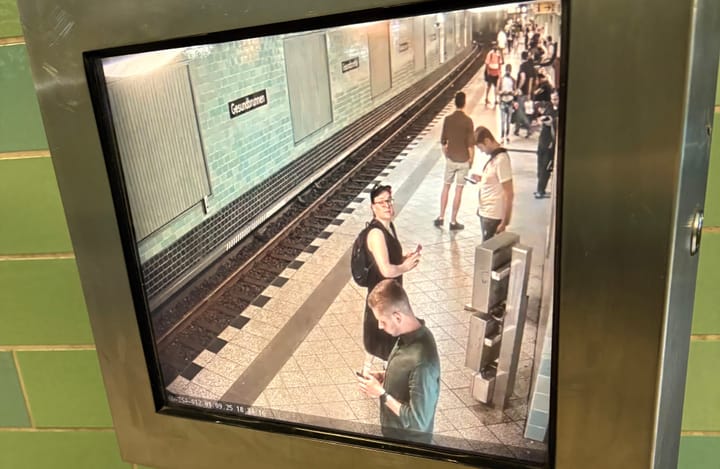


Comments ()